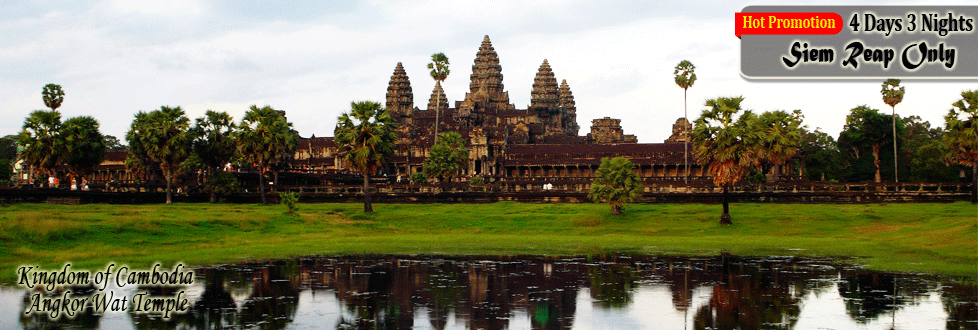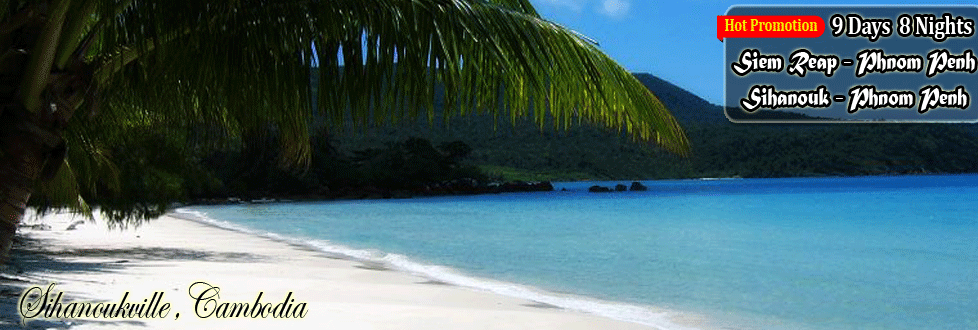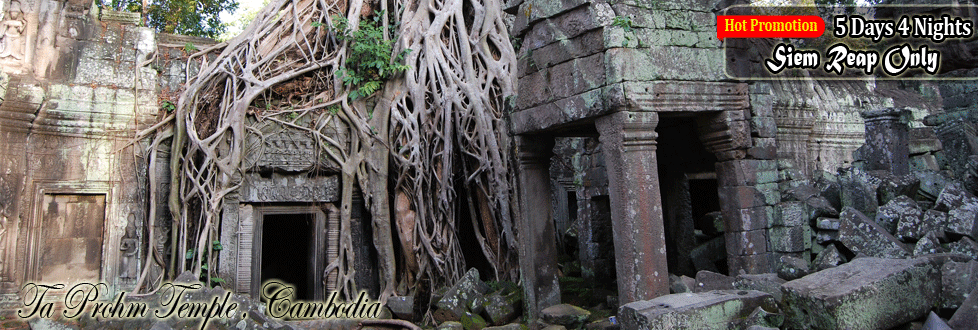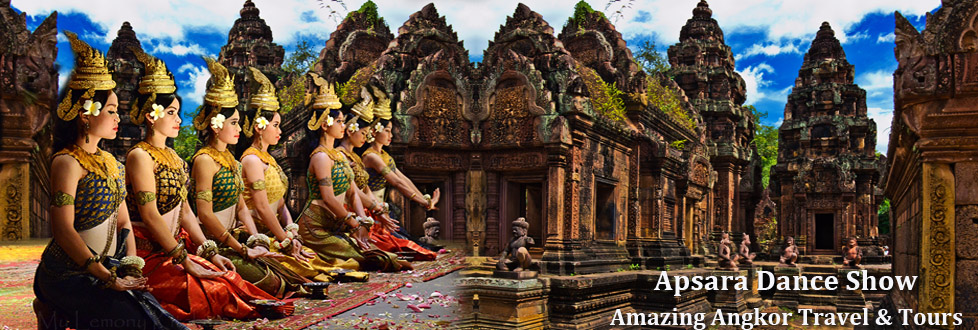Cambodia Clothing
What type of clothes/shoes are good for site seeing? Answer: Yes, the clothes for sightseeing temples and palace here should be normal clothes but should not wear short shirt or short pant and T-shirt or shirt should cover shoulders
Sampot
Apsara dressed in Angkorian-style sampot cloth. The sampot is the national garment of Cambodia. The traditional dress is similar to those worn in the neighboring countries of Laos and Thailand, but variations do exist between the countries. The sampot dates back to the Funan era when a Cambodian king allegedly ordered the people of his kingdom to wear the sampot at the request of Chinese envoys. There are many variations for the sampot, each is washed according to social class. The typical sampot, known also as the sarong is typically worn by men and women of lower class. It measures approximately one and a half meters and both ends are sewn together. It is tied to safely secure it on the waist.
Sampot Chang Kben
Sampot Chang Kben ( សំព ��?់​ចងក្បិន, ALA-LC: saṃbát caá¹… kpin) is the preferred choice of clothing for women of upper and middle classes for daily wear. This practice of daily wear died out in the beginning of the twentieth century. Unlike the typical Sampot, it is more of a pant than a skirt. It is a rectangular piece of cloth measuring 3 metres long and one metres wide.[2] It is worn by wrapping it around the waist, stretching it away from the body and twisting the knot. The knot is then pulled between the legs and held by a metal belt. Regardless of class, all Cambodian women wear the Sampot Chang Kben on special events. Men may also wear it, but the traditional patterns depend on gender. The Sampot Chang Kben is adopted in Thailand and Laos, where it is known as Chong Kraben. It dates to the to ancient Cambodia where deities often wore such styles.[3]
Sampot Phamuong
Sampot Phamuong (សំព��?់​ផាមួង ALA-LC: saṃbát ph�? muaá¹…) are many different variation of traditional Khmer textiles.[4] They are single colored and twill woven. There are currently 52 colors used in Sampot Phamuong. The Phamuong Chorabap is a luxurious fabric using up to 22 needles to create. Phamuong variation are rabak, chorcung, anlounh, kaneiv and bantok. It usually contains floral and geometrical motifs. The most valued silk used to create the Phamuong is Cambodian yellow silk, known for its fine quality. New designs draw inspiration from ancient patterns of old silk.
Sampot Hol
Sampot Hol (សំព��?់​ហូល ALA-LC: saṃbát hÅ«l) is a typical traditional textile. There are two kinds of Sampot Hol, one is a wrapping skirt that uses a technique called chong kiet and twill weave. Influenced by the Indian patola, it developed patterns and techniques over the centuries to become a genuine Khmer art style. The sampot hol has over 200 patterns combined with three to five colors, yellow, red, brown, blue, and green. There are four variations, sampot hol, sampot hol por, sampot hol kben and sampot hol ktong. Patterns are usually geometric motifs, animals, and flower motifs.
Both Sampot Phamuong and Sampot Hol believed to have invented from original Sampot in Oudok Era as word Phamuong comes from Siam language that Pha mean Fabric and Mung mean violet while Sampot Hol had introduced as ceremonial skirtcloth to the Thai court as sompak poom or pha poom in 19th century.[5][6] Although that era, Thai culture influenced that much into Khmer society, Khmer weaving however, is not a copy from Siam, because Cambodia already had a weaving culture before the Klung civilization. At this time, Cambodia still do not know what the word like Phamung meant in that time.
Sampot Tep Apsara
Sampot Tep apsara Angkor (Khmer: សំព��?់ទ��?ពអប្សរាអង្គរ) is famous sampot in Khmer empire era, which still found on the bas belief of Apsaras carving aroung Khmer Famous temple, Angkor wat. Generally, all of thoes skirt had tied to safely secure it on the waist with their style of golden belt, drop a long pleat at the middle of Sampot which the length of that fabric recoil at the calf of the leg. The hem of skirt at the both part always get a small knot up. There are also two knots come from the waist of sampot with the left Knot is the long knot like the thin long fabric while the right Knot in the same pgysical appearance but more decortion at the middle of it knot. Today, this style of sampot become the fictional skirt for nowadays people as No of this kind of sampot wearing by anyone but will an illustration to public as it will wearing in some show as they disgus as Apsara.
Sampot Samloy
Sampot Samloy (Khmer: សំព��?់សំម្លុយ) is long skirt used daily for men and women. The name Samloy mostly refers to no colour but black for ancient name, now it is sometimes recognized as the soft, thin fabric with more decoration and pattern look Sarong Batik but may be smaller. With its thin and soft appearance, the style of dress had been required to hold a knot, make it to become Sampot Chang Kben easily. However, it is necessary to make a fold at the left or right side like Sarong and Another sampot but most of female wearer, likely to hold its knot at up middle, drop a small division site at the length of Saloy at the knee to be easily to walk for the wearer. Saloy was known to be popular during Chatomok Era.
Sampot Chorabap
Sampot Chorabap (Khmer: សំព��?់ចរបាប់) is a long skirt of silk embroidered all over the gold thread,, worn by woman in Khmer classical dance, newlywed and the character of Mae Hua (Khmer: ម��?​ហួ) in Royal Ploughing Ceremony of Cambodia.
Sampot Sang
Sampot Sang (Khmer: សំព��?់ស��?ង) is a short skirt with silk embroidery.
Sampot Seai Sua
Sampot Seai Sua (Khmer: សំព��?់សែសយ) is a kind of skirt of one colour with a gold or silver embroidered band along a lower ham. roday, this skirt is very popular among Laotian's lady than Khmer people.
Sampot Lbak
Sampot Lbak (Khmer: សំព��?់លើ្បក) is a long skirt covered with entirely silk embroiredy. Today it is worn in marriage ceremonies in the place like Sampot Sabum. In ancient times, This kind of sampot is mostly worn by Noblemen of Cambodia during Lovek era.
Sampot Aslom
Sampot Aslom (Khmer: សំព��?់អន្លូញ) is a long skirt with the vertical stripes, commonly worn by old people or farmer in the countryside. This one is share highly common to Burma's Longyi.
Tops
There are many variation of Tops known as Shirt in Cambodia. The invention of traditional Aor is found after Khmer empire era at the late of 13 century to 14 century
Chang Pok
Chang Pok (Khmer: អាវចងពង់) is a piece of fabric in any colour which Khmer people at the late of 13 century especially women, started used it to cover their chest, showed up only the stomach. The style of Covering, is cover it at the back and each side of the fabric to join at the middle the chest and roll it to up to be smaller to tie which this style called Chang Pok.It then developed more to Tronum which is a thick and strong fabric cover on the chest of khmer lady, which stick on the body strongly. Sometimes, the commonly style of wearing this garment is similar way to wearing Aor Chang Pok, just Aor tronum, not showed as much skin like Aor Chang Pok. Popularity of wearing Aor Tronum, were for young rich lady during Chatomok Era and today an important costume of all to be used in Khmer classical dance.
Av Bupong
Av Bupong (Khmer: អាវ​បំពង់)mean tube skirt in English according to appearance like a long tube, bribe to the body at the head and drop to down easily. Aor Bupok is a long shirt like a dress than the regular shurt similar to Vietnamese Ao Dai, Indian's Kurta and Malaysia's baju kurung. Generally, It has a Collar with a button at the length from the neck to chest like Kurta while it normally norrow at the middle of the shirt in the stomach part like Baju Kurung but has the small hidden cut at hem of each shirt of shirt like Ao Dai which allowed the below part of shirt turn to Wide and Big. Most of Shirt is length at the knee while few one just only Length at the thigh. This Shirt is famous during Lovek to Oudong era worn by rich lady.
Av Dai Puon
Av Dai Puon is a traditional blouse in Lovek era. The name of dai puon is literally meaning according to inflated short arm. This shirt usually had a row of button and just of few of extremely rich girl counld had one during that era.
Av Pnot Kback
Av Pnot Kback is the female formal shirt used for rich young lady. The whole row of its pleat filled with the decoration of flower paird with the collar and the hem of arm in the same style. This shirt invention period is not specifics but most of people believed it going to Lovek. This one is quiet similar to Burma one, as maybe one of least inflnuced of Burma culture.
Av Neang Nov
Av neang nov is a the long arm shirt, worn by woman.
Av Bar Bov
Av Bar Bov is a no arm coat wear on the Av neang nov and Av Dai Puon. This shirt had the dounble of Button on its pleat. The name of Av Bar Bov is known as Lotus leaves, the literally meaning from Thailand.
Av Pak
Av Pak is a recent popular fashion blouse in Cambodia worn by Woman. This one is known as the khmer version of Kebaya with plain stamped cotton elaborately hand-painted embroidered silk with gold thread. In the past, this kind of shirt required it own unique style with only white colour with the high full of embroider. Today, This shirt has the more gold thread in several colour and had cut into a lot of modern fashion which highly popular to Khmer people especially middle aged and young woman with the narrow style and several decoration model. This shirt had been noted as today's khmer national costume where a lot of khmer girl had used this blouse at the special occasion both inside and outside Cambodia to revived the khmer identity. This shirt usually worn with Sampot Hol and a few worn with Sampot Chang Kben
Krama
Traditionally Cambodians wear a checkered scarf called a "Krama". The Krama has been a symbol of Cambodian dress since the first century reign of Preah Bath Hun Tean although it is not clear when exactly the krama became fashionable in the streets.
A Cambodian woman wearing a conical hat to keep off the sun's heat in the rice fields. Her krama is worn underneath
The "krama" is what distinctly separates the Khmer (Cambodians) from their Thai, Vietnamese, and Laotian neighbors. The scarf is used for many purposes including for style, protection from the hot sun, an aid (for your feet) when climbing trees, a hammock for infants, a towel, or a "sarong". A "krama" can also be easily shaped into a small child's doll for play. Under the Khmer Rouge, all Khmer were forced to wear a checkered "krama".
The conical hat is also worn by many particularly by workers in the countryside to keep the sun off. This, however, is a Vietnamese hat that has been adopted to a certain extent by Khmer in the provinces adjacent to Vietnam.
Laos Clothing
Laos Clothing, in its traditional form, consists of dresses original to the Hmong community of Laos. Laos clothing was a symbol of the individuality of the sub-group of Hmong living in Laos. However with time the influence of the outside world has limited the wearing of traditional Laos clothing to special occasions only.
The traditional clothing of Laos is different for men and women. While men's clothing is simpler the clothing of women of Laos is elaborate and decorated with embroidery and designs. The men of Laos wear pants with a shirt and vests. The women wear a sarong like cloth with a shirt or a jacket.
The use of colorful bands worn around the waist by both men and women is a part of Laos clothing. Women also wear large headdresses as a part of the traditional costume of Laos. The modesty of the women's clothing of Laos makes them much more beautiful and charming.
The hand woven clothing of Laos was generally made of hemp. The recent times have seen the use of artificial material in the making of clothing. Various designs and patterns give Laos clothing a wide range of different options to choose from. The myriad colors of Laos clothing range from common colors like black and white to vibrant and bright colors like pink and green and blue.
The Western influence on the people of Laos has also affected the style of clothes they wear. People of Laos have started wearing Western clothing for regular purposes. The traditional Laos clothing has been limited to festive occasions only.
What Kind of Clothing Do Laos People Wear?
Traditional Laotian clothing arose centuries ago and spread through the major ethnic groups, specifically the Lao and Hmong. Colorful patterns and bright colors remain popular for traditional clothing styles, though modern, Western-style dress now dominates everyday city life in Laos.
Popular for both men and women
Women's Clothing
Both traditional Lao and Hmong outfits emphasize bright pink, yellow or blue colors. Lao dress tends to be more form-fitting, with a sarong and top, and emphasizes elaborate, embroidered designs. In contrast, Hmong dress includes patterns of dangling beads on skirts, long-sleeved tops and broad, round hats.
Jewelry
Laos is also known for its silver jewelry. Broad, woven cuffs remain a popular style among the Lao, while the Hmong favor elaborate, woven necklaces in the shape of an inverted pyramid as well as large, dangling earrings.
Traditional to Modern
With Western influences and factory production, most Laotians wear Western-style clothes for daily professional and private life. Nevertheless, traditional Laotian clothing remains common for special occasions such as weddings and Lao New Year. In addition, many groups in remote communities, such as the Mien and Akha, tend to wear traditional clothing on a daily basis.
What Kind of Clothing Do People Wear During Hanukkah?
The Jewish holiday of Hanukkah does not have a traditional outfit associated with it. When celebrating the holiday, guests or individuals are free to wear any clothing they wish. While there are no specific clothing requirements for the holiday, there are some clothing options that act as a reminder of the holiday.
Blue and White
The official colors of Hanukkah are blue and white, so wearing an outfit in the holiday colors would an appropriate clothing option. Consider a pair of white pants and a blue shirt, a white skirt with a blue blouse or blue jeans with a white shirt.
Formal Events
For a formal Hanukkah event, wear the appropriate attire for the party and add Hanukkah elements to the clothing with a few extra touches. For example, a woman might wear a necklace with a delicate star of David or a tiny menorah pendant, while men might wear a light blue tie. Men can also wear a kippah for the holiday.
Sponsored Links
Emma Bridgewater Apparel
Online shop for Wellington Boots Raincoats, Umbrellas and more. grantbarnett.com/emmabridgewater
Casual Family Get-Together
For a casual get-together with close friends and family, any outfit is appropriate. Wear jeans and a T-shirt with a dreidel or a menorah graphic. A shirt with the words "Happy Hanukkah" and star of David in the words is also appropriate for a casual get-together.
Children's Clothes
Children's Hanukkah outfits are available for parents to purchase such as baby T-shirts with an image of a baby playing with a dreidel or a child opening a present. For a more formal look, children can wear dresses or suits in the classic Hanukkah colors of white and blue
Myanmar Clothes
Clothes
- Light cotton or linen clothe, easy to carry and to clean. The best is to buy a Burmese "Longyi" (few dollars) and the Burmese will really like it.
- In winter time , take a sweater and trouser for the mountain area and all the Shan State, it is cold at evening time and during the night (between 5C° and 15C°), especially in Pwin Oo Lwin and at Inle Lake.
- Do not forget a hat and sun block cream for Inle Lake and Golden Rock. The sun is hot and you are above 3 000 feet.
Shoes
Take shoes which are easy to remove. You have to remove your shoes very often in Myanmar, to enter the houses, to enter the pricint of the pagodas.
To also avoid heat or moisture problem, it is better to use open shoes. If you can during the rainy seasons, it is very important to use open shoes, not tennis or closed shoes. The humidity level is so high that you are sure to get fungus problem with tennis shoes.
The best is to do like the Burmese, use sleepers, it is perfect and you can buy very good and very cheap one every where in Myanmar.
What to Wear in Thailand
There is an amazing choice of very smart hotels, bars and restaurants - often with a very western feel, and it is easy to forget that whilst the hotels may look the same as in the west the Thai people are conservative people.
They are quite modest dressers and it's an integral part of their culture, not a fashion statement.
In mainland Thailand, no matter how hot it is don't wear sleeveless vest tops or short shorts when in public areas.
Showing cleavage is also a bad idea and is thought to be in bad taste.
Neat, clean clothing makes you look good and is the best bet for good respect from the Thais.
If you are staying in a hotel it's a good idea to take light knitwear or a pashmina shawl as the air conditioning can be fierce at times.
People seem to make more of an effort to dress smartly for dinner in the hotels and a smart top or dress and shoes will be useful. A wrap is also very versatile and can dress up any outfit.
If you are going to visit any temples wear shirts or blouses with sleeves and carry a sarong or wear a skirt. Also remember that you will have to take off your shoes. Wear shoes that can be easily removed because you cannot wear shoes in the Buddhist temples. Socks are considered poor form and tacky. Comfortable flip flops or sandals work well if trainers or walking shoes don't appeal.
Northern Thailand enjoys hot daytime temperatures throughout the year although evening temperatures are a good deal lower from October - March when you will need to pack warmer layers or a pashmina for the evenings. Good sturdy walking shoes are vital. Make sure you take plenty of sun cream and bug spray with you as it is very difficult to buy locally in the north and if you do happen to find some it will be expensive.
If you're planning to go elephant trekking or even a short ride on one, make sure you have long trousers because you will get dirty and dusty - if not wet.
If your trip includes Thailand's islands such as Phuket, the key word here is ‘relaxed'. All types of dress are acceptable here and you'll see a huge variety. The weather's always hot, so you really don't need much and if you're backpacking, it pays to pack light. Our advice is to take a day pack with you and buy everything there – clothes and toiletries are just so cheap that it's really not worth carrying them from one country to the other and then back again.
If you're here on business then a smart suit is the order of the day. Thai women would normally wear a skirt suit rather than a trouser suit.
Don’t drink or even brush your teeth in tap water. Consider taking a waterstraw water purifier or safe drinking water bottle.
Keep bottled water out of the sun as the plastic bottles can release dioxins when they heat up, which is not healthy. An alternative is to use a 100% BPA-free foldable water bottle. Reusing your water bottle will also help you do your bit for the planet - millions of plastic water bottles end up in landfill every year.
If you are able to visit a local school they are very grateful for new materials. See the Pack for a Purpose project for ideas of what you could donate.
What to Wear in Vietnam
The Vietnamese are used to European styles and western dress has been adopted this means​that travelers can dress as they would in the west when visiting restaurants or the bars of the main cities.
Ho Chi Minh is pretty westernized and there are lots of students on gap years as well as bank workers from the west living out there, so really what you would wear in any western city will fit in. There really isn't the big need to cover up that there is in the rest of Vietnam.
As a general rule though the North is noticeably more conservative than the South. The basic rule of thumb is not to wear revealing clothing at any time.
During most times of the year but particularly during our summer months, The Mekong Delta region can be plagued by mosquitoes so long sleeves should be worn from dusk to avoid being bitten.
Clothes are really cheap here so you don't really need to pack too much and its a great excuse to go shopping when you arrive.
For the Vietnamese, appearance is very important, so if you are dealing with an official of any rank, make sure you are dressed smartly.
Do not wear large amounts of jewellery – the Vietnamese consider it impolite to flaunt wealth in public.
Wear particularly conservative clothing if you visit a culturally sensitive area such as a temple or pagoda – generally, the less bare skin the better and specifically, no shorts, dresses, skirts or tops with low neck lines and bare shoulders.
It's really is important to pack for almost all weather conditions.




.jpg)
.jpg)
.jpg)

.jpg)
.jpg)
.jpg)

.gif)

 Visa and Passport
Visa and Passport 


.png)
